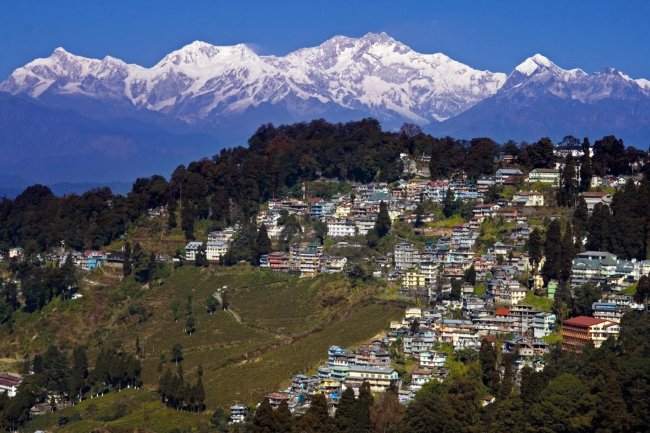History Of Delhi Monuments
Delhi is home to many monuments that have stood the test of time and tell the story of its rich and varied history.

History Of Delhi Monuments
1. India Gate
write history about India gate is a war memorial located in New Delhi, India, built in 1931 to commemorate the Indian soldiers who died in World War I and the Third Anglo-Afghan War. It is a prominent landmark in the city and stands at the eastern end of the Rajpath, a large avenue that runs from the Rashtrapati Bhavan (President's House) to the India Gate.
The foundation stone of India Gate was laid by the Duke of Connaught on 10th February 1921 and was designed by Sir Edwin Lutyens. It stands at a height of 42 meters (135 feet) and is built in the style of the Arc de Triomphe in Paris. The gates of India Gate are inscribed with the names of more than 13,516 Indian soldiers who died in World War I and the Third Anglo-Afghan War.
India Gate is lit up with floodlights at night and is a popular spot for picnics and leisurely strolls. The area around the gate is known for its lush green lawns and gardens. It has become a symbol of national pride and is one of the most visited tourist attractions in New Delhi.
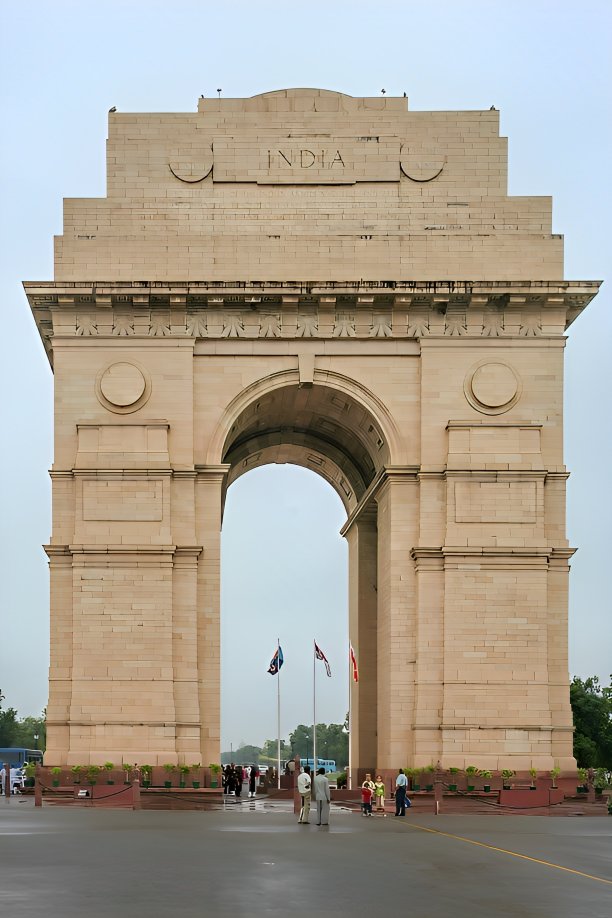
2. Humayun Tomb
The Humayun Tomb is a mausoleum located in Delhi, India, that was built for the Mughal Emperor Humayun. It was commissioned by Humayun's first wife and chief consort, Empress Bega Begum, in 1569-70, and designed by Mirak Mirza Ghiyas, a Persian architect chosen by her. It was the first garden-tomb on the Indian subcontinent and is located in Nizamuddin East, Delhi. The tomb was declared a UNESCO World Heritage Site in 1993, and since then has undergone extensive restoration work, which is still underway. The complex encompasses the main tomb of Emperor Humayun, which houses the graves of numerous other Mughal rulers and their families, including that of Humayun's wife, Haji Begum, and later Mughal emperors, such as Jahandar Shah, Farrukhsiyar, Rafi Ul-Darjat, Rafi Ud-Daulat, Muhammad Shah and Alamgir II. It was also the first structure to use red sandstone at such a scale. The Humayun Tomb is seen as a clear departure from the fairly modest mausoleum of his father, the first Mughal Emperor Babur, called the Bagh-e Babur (Gardens of Babur) in Kabul, Afghanistan. Though the latter was the first Emperor's first resting place, it was not a proper mausoleum. At the time of the Slave Dynasty, this land was under the KiloKheri Fort which was the capital of Sultan Kequbad, son of Nasiruddin. The construction began in 1565, nine years after his death, and was completed in 1572 AD at a cost of 1.5 million rupees. The cost of building the mausoleum was paid entirely by Empress Bega Begum. It was designed as a square with four gates, one in each direction. The mausoleum is located on the bank of the Yamuna River in Delhi. The structure is made of red sandstone and is surrounded by Charbagh gardens (a type of Persian garden). It is entered through two stairways on the western and eastern sides of the complex. The complex is located in the Nizamuddin East area of Delhi, close to the Dina-Panah Citadel, also known as Purana Qila, which Humayun founded in 1533. The mausoleum is one of the best-preserved examples of Mughal architecture in India.
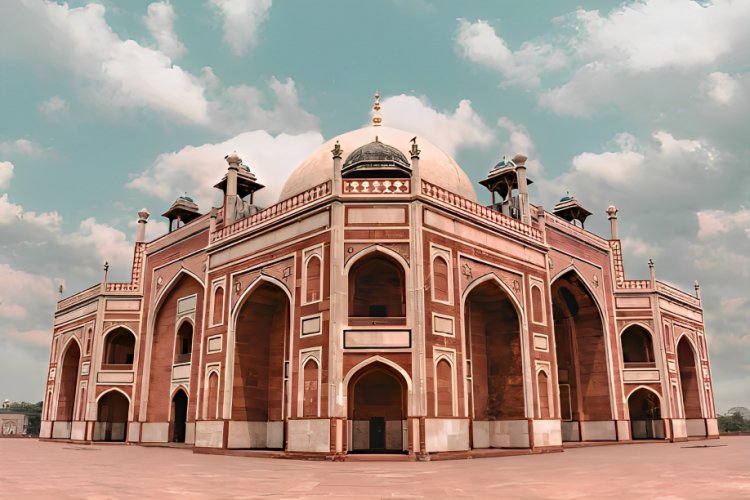
3. Qutub Minar
Qutub Minar is a 73-meter-tall landmark in Delhi, India. It is the second tallest minaret in India and is considered to be one of the most important monuments of the country. The tower was built in the early 13th century as a victory tower by Qutb-ud-din Aibak, the first Sultan of Delhi. It was later rebuilt and expanded by his successors, Iltutmish and Firoz Shah Tughlaq. The tower is made of red sandstone and marble and is inscribed with intricate carvings and verses from the Quran. It is also surrounded by numerous other ancient monuments, including a mosque and other buildings. Qutub Minar has long been a symbol of Islamic architecture in India and is a popular tourist destination in the country.
The exact history of Qutub Minar is not known, but it is believed to have been built to commemorate the victory of the Muslim rulers over Delhi's last Hindu kingdom in 1192. According to some accounts, the tower was built as a symbol of Islamic architecture, while others suggest that it was meant to be an astronomical observatory. The tower was initially built with a base diameter of 14.3 meters and a height of 72.5 meters. However, it was later damaged by lightning and was rebuilt and expanded by Iltutmish and Firoz Shah Tughlaq to its current height of 73 meters.
Throughout its history, Qutub Minar has been a symbol of the various rulers who have held power in India. It has been a source of inspiration for many artists and architects and has been featured in numerous films and television shows. Today, it is an important part of India's cultural heritage and is protected as a UNESCO World Heritage Site.
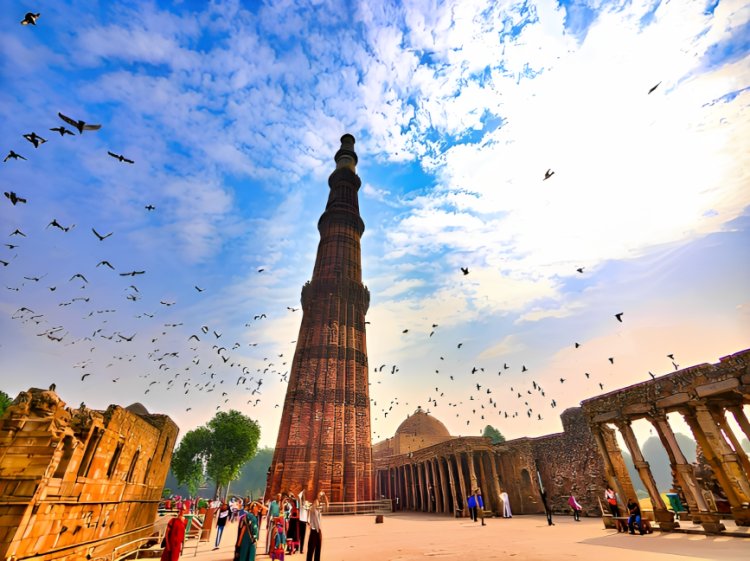
4. Safdarjung Tomb
The history of the Safdarjung Tomb dates back to the 18th century when it was built as a mausoleum for a powerful Mughal nobleman, Mirza Muqim Abul Mansur Khan. Khan served as the Prime Minister of the Mughal Empire from 1748 to 1754 and was known as one of the most influential personalities of his time.
It was the last monumental tomb of the Mughal era and was built in 1754 under the orders of the Mughal Emperor, Muhammad Shah. The tomb was designed by an architect named Nawab Zain Yar Jang Bahadur and was constructed with red sandstone and marble. The structure of the tomb is heavily influenced by Mughal architecture, with a large octagonal chamber at the center and four smaller chambers around it. The tomb also features a large dome and several smaller domes, as well as arched openings, minarets, and an impressive gateway.
The Safdarjung Tomb was initially built as a place of worship for Mirza Abul Mansur but soon became a popular tourist attraction after his death. Today, the tomb is one of the most visited monuments in Delhi and is a popular film shooting location. It has also been declared a protected monument by the Archaeological Survey of India and is now considered to be a major landmark in the city. The Safdarjung Tomb is a reminder of the grandeur of the Mughal Empire and is an important part of Delhi's rich history. It is an important example of Mughal architecture and is worth a visit for anyone interested in the history and culture of India.
5. Red Fort
The Red Fort, also known as the Lal Qila, is one of the most famous and iconic monuments of India. It is located in the historic city of Delhi and is a symbol of the country’s rich culture and heritage. This magnificent structure was built by the Mughal emperor Shah Jahan in the 17th century, and it has played a major role in the history of India.
The Red Fort was constructed between 1638 and 1648, and it was the primary residence of the Mughal emperors. It was built using red sandstone and white marble, and it was meant to symbolize the power and grandeur of the Mughal empire. The fort was designed to be a walled city and was surrounded by a moat and double walls. The walls of the fort were designed to be impenetrable, and it was equipped with state-of-the-art defense systems.
The Red Fort served as the political and cultural center of the Mughal empire for more than two centuries. It was here that the Mughal emperors held court, issued laws, and conducted state affairs. The fort also served as a center of trade and commerce, with merchants from all over the world coming to trade goods and services. Today, the Red Fort is a popular tourist destination, and it is a symbol of India’s national pride. Every year, on India’s Independence Day, the Indian Prime Minister hoists the national flag atop the fort’s ramparts and addresses the nation.
The Red Fort is also home to several museums and galleries, which showcase the history and culture of the Mughal era. The Red Fort is a testament to the grandeur of the Mughal era, and it is a reminder of India’s rich and varied history. It is one of the most popular tourist destinations in the country, and it is a must-visit for anyone looking to explore the history and culture of this great nation.
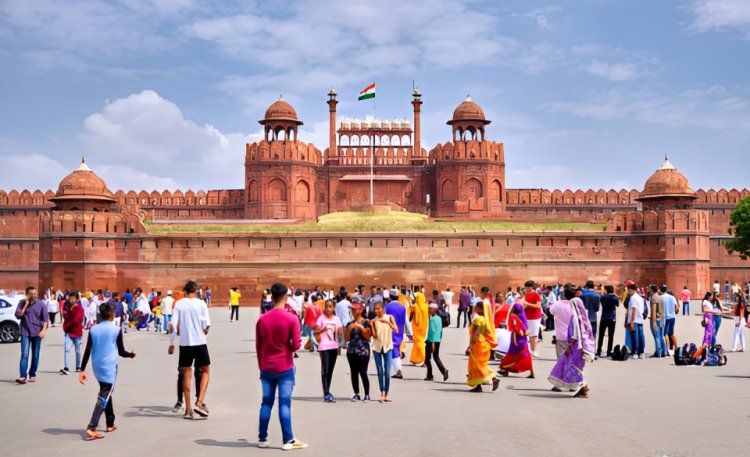
6. Lodhi Garden
Lodhi Garden is one of Delhi’s most beautiful and historic gardens. Located in the heart of the city, it was once the site of the 15th-century Lodhi dynasty’s royal palace. The garden is spread over 90 acres and is home to a number of monuments and tombs that date back to the 15th and 16th centuries. The garden was originally designed and constructed by the Sayyid and Lodi rulers of the Delhi Sultanate in the 15th century. It was then maintained by the Mughals and was part of the royal palace complex of the Mughal Emperors. The garden was later used by the British as a camping ground and for military exercises. The Lodhi Garden is home to several monuments, tombs, and mosques that reflect the history of the city and its rulers. Some of these include the Tomb of Sikandar Lodi, the Bara Gumbad, the Shisha Gumbad, the Athpula Bridge, the mosque of Mohammed Shah, and the Tomb of Sikandar Lodi.
The garden also houses a number of other monuments and sculptures, including the Akbar's Tomb and the Bada Gumbad. The garden is a popular destination for tourists, who visit to take in the beauty of the monuments and enjoy the peaceful setting. There are also a number of recreational activities available, such as boating, cycling, jogging, and picnicking. The garden has also been featured in numerous movies, TV shows, and advertisements. Lodhi Garden is a great place to spend a relaxing day and explore the history of Delhi. Visitors can enjoy the views of the monuments, the lush green lawns, and the peaceful atmosphere. The garden is a perfect spot for a leisurely walk or an evening picnic. So, if you’re looking for a place to relax and explore the history of the city, head over to Lodhi Garden.
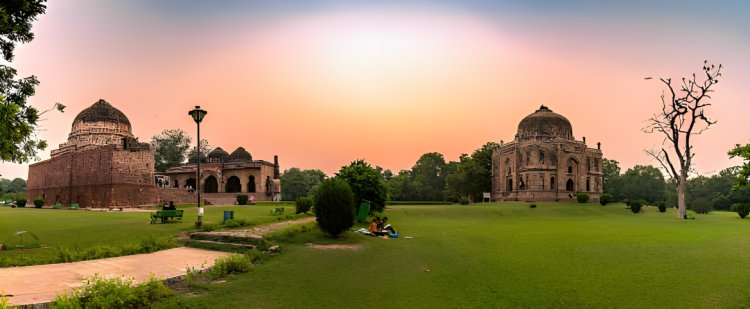
7. Jama masjid
Jama Masjid, also known as the Masjid-i Jahan-Numa, is one of the most famous mosques in India. It is located in the old walled city of Delhi and is considered to be the largest mosque in India. The mosque was commissioned by Mughal Emperor Shah Jahan in 1650 and was completed in 1656. Jama Masjid stands on a high plinth and is surrounded by several smaller buildings and courtyards. The main courtyard is about 66 meters square and can accommodate up to 25,000 people at once. The mosque has three huge gateways, four towers, and two 40-meter-high minarets.
The walls of the mosque are decorated with intricate carvings and inscriptions from the Holy Quran. The mosque was built by more than 5,000 artisans, and it cost one million rupees to build. The main entrance of the mosque features an inscription that reads "if there is paradise on earth, it is here" which is a testament to its grandeur and beauty. Jama Masjid has served as a place of worship for generations of Muslims in Delhi.
It is also a popular tourist destination and many people come to marvel at its beauty and grandeur. The mosque is also a center for religious learning and Islamic teachings. Jama Masjid is a symbol of the rich Mughal culture and heritage of India. It has a long and fascinating history which is still being explored and studied today. The mosque stands as a reminder of the great Mughal Empire and its immense influence over the region. It is a place of immense beauty and spiritual significance which will remain a part of Indian culture and history for many years to come.
8. Jantar Mantar
Jantar Mantar is a collection of architectural astronomical instruments, built by Maharaja Sawai Jai Singh II of Jaipur, India in the early 18th century. Jantar Mantar is the most significant and well-preserved of five similar astronomical observatories built by Jai Singh between 1724 and 1730.
The purpose of the observatories was to compile astronomical tables and to predict the times and movements of the sun, moon, and planets. The observatory consists of fourteen major geometric devices for measuring time, predicting eclipses, tracking stars in their orbits, ascertaining the declinations of planets, and determining the celestial altitudes and related phenomena. The observatory was inscribed on the UNESCO World Heritage list in 2010 as “an expression of the astronomical skills and cosmological concepts of the court of a scholarly prince at the end of the Mughal period”. It is one of the largest and best preserved of the five observatories built by Jai Singh. The instruments at Jantar Mantar have been astonishingly accurate. The Samrat Yantra, for example, can tell time accurately to within two seconds. The most impressive and accurate of the instruments is the Jai Prakash Yantra, which is a form of a solar telescope. It is composed of two large concave hemispheres facing each other. The shadows of the hemispheres are used to measure the position of the sun and predict solar eclipses. Jantar Mantar has become a popular tourist attraction in India and is visited by thousands of tourists each year. The observatory is a symbol of the scientific and technological advancements made in India during the Mughal period. It stands as a testament to the intelligence and achievements of the people of that era, who had the vision and knowledge to build such a complex and accurate astronomical observatory.

9. Purana Qila
In the bustling capital of India, Delhi stands the majestic Purana Qila or Old Fort. It is considered to be one of the oldest forts in India, with some historians believing it was built before the arrival of the Mughals in India. The Purana Qila is believed to have been constructed by Humayun in 1533 CE after he returned from exile in the Middle East. He wanted to build a fort that would be impenetrable, so he chose the location of the fort carefully, on the banks of the Yamuna.
The Purana Qila has seen many battles and invasions over the years. It was attacked by Sher Shah Suri in 1540 CE, who defeated Humayun and took control of the fort. Later, it was attacked by the Mughal Emperor Akbar in 1556 CE. He was successful in defeating the Afghans and annexing the fort to his empire. The Purana Qila has seen many changes and renovations over the years. Under the Mughals, the fort was extensively renovated and improved. Akbar built a number of new structures and commissioned a number of works of art. Today, the Purana Qila is a popular tourist destination in Delhi.
Visitors can explore the fort and its various structures, such as the mosque and the baoli (stepwell). The fort also houses a museum where visitors can learn about the history of the fort and its many rulers. The Purana Qila is also a popular venue for cultural events. It is host to the annual Qila-e-Qutub Festival, which showcases the best of Indian culture and heritage. The Purana Qila is a testament to the rich and turbulent history of India. It is a reminder of the many rulers who have come and gone, and the many battles that have been fought in its walls. It is a symbol of India's strength and resilience, standing proudly in the modern capital of the country.
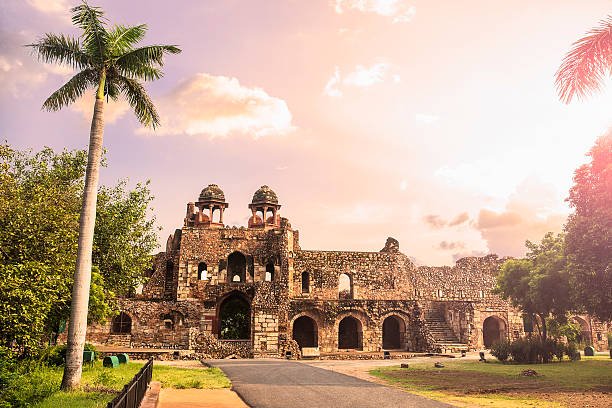
10. Tughlaqabad Fort
Tughlaqabad Fort is a 14th-century fort built by the Tughlaq dynasty in Delhi, India. It was built by Ghiyas-ud-din Tughlaq, the founder of the Tughlaq dynasty, to be his capital in 1321. The fort was built to protect the city of Delhi from potential invaders, and its walls and bastions were designed to be impenetrable. The fort was abandoned in the 15th century and fell into disrepair.
The origin of the Tughlaqabad Fort dates back to 1320 when Ghiyas-ud-din Tughlaq assumed the throne of the Delhi Sultanate. He had a vision of building a grand city with a fort that would be the pride of the Sultanate. He began construction of the fort in 1321 and it was completed in 1325. The fort was built on a rocky outcrop of land overlooking the Yamuna river. Its walls and bastions were designed to be impenetrable, and it was equipped with a range of weapons and ammunition. The fort was built in the shape of a rectangle and was surrounded by a moat. The entrance was guarded by two colossal towers on either side of the gate. Inside the fort was a palace, mosques, markets, granaries, and other buildings. The fort remained the capital of the Tughlaq dynasty until 1412 when the dynasty fell.
The fort was abandoned and fell into disrepair. In the 16th century, the Mughal Emperor Akbar attempted to restore the fort but was unsuccessful. In the 19th century, the British attempted to restore the fort but were only partially successful. Today, the fort remains in a state of disrepair but it is a popular tourist destination. Tughlaqabad Fort is a testament to the grandeur of the Tughlaq dynasty and is a reminder of the rich history of Delhi. It stands as a symbol of resilience and strength, and it is a reminder of the power and might of the Sultanate of Delhi.
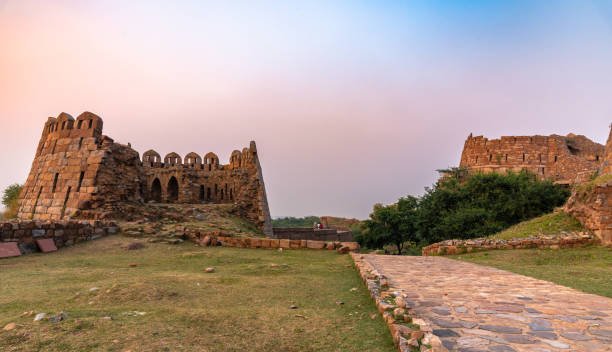
What's Your Reaction?










